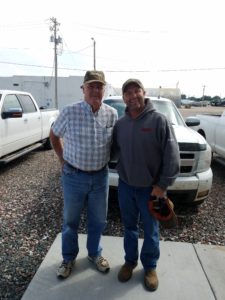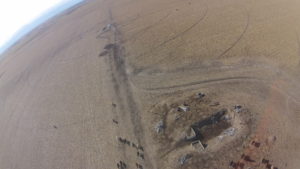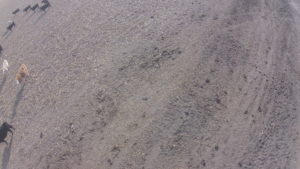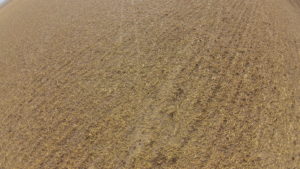Farmers boost days of corn stubble grazing for cattle with Bio-Mulch
Here’s something to ruminate on. Near Scottsbluff, Nebraska a farmer-rancher found over the last winter that his cattle preferred grazing Bio-Mulch™ 7-0-0 treated corn stubble so much that for a remarkably long time they wouldn’t even bother with the neighbor’s untreated half-pivot.

And consider the production economics that resulted. The cattle required less supplemental feed over the winter, and the corn fields gained bonus manure to offset fertilizer costs in the spring.
“How this got brought up was that my neighbor called and asked what was sprayed on those stalks because no cows will come to his field, and he needs to get the residue eaten up,” says Leo Hoehn. “We went up there and sure enough, all the cattle were on the treated half of the circle even though we thought it had been grazed down about right. They wanted more of the treated stubble, not the neighbor’s field even though they had full access.”
They stayed, and stayed. They remained on that treated field more than three times as long as would be typical – 135 to 145 days compared with 35-45 days, Hoehn says.
“I’ve been grazing herds of mother cows on corn stubble for 40 years, but I’ve never seen something like this,” says Hoehn. “We normally expect about 45 days of grazing per cow per acre. But we far exceeded that.”
The palatability was apparent. There was no corn on the ground from harvest lost. Yet, after feeding on the stubble, the cows usually were lying down by late morning, an indication of good feed and contentment.
The condition of the cattle was good, with an average body condition score of 6, Hoehn says. Extension beef specialists caution that there can be slight risk for digestive disturbances when cattle feed on corn stubble. Hoehn said there was no bloat, acidosis or founder in the herd of mother cows feeding on the treated stubble.
“Any cattle producer who can pay the typical $15/acre for corn stubble grazing and get 145 days vs. 45 days out of it, with no adverse health or conditioning issues, is going to say that’s a good deal,” says P.J. Hoehn, Leo’s nephew, who is also his crop advisor with J.R. Simplot Company. “There is a significant savings in feed costs for those extra days they’re on the corn.”
For the landowner, the extra days of manure deposited for this year’s corn crop is a bonus. When cattle remain on a field three times longer, there’s three times the manure. Aerial imagery of the treated and untreated fields showed distinctly more manure on the treated acres.

Plus, the improved reduction of stubble makes it easier to get the tillage equipment and the planter through those fields in the spring, says P.J.
As owner of both the land and the cattle, Leo Hoehn is doubly pleased with the results.
What Bio-Mulch Does
“Bio-Mulch is shown to increase the cycling and plant-availability of soil nutrients, but turning ordinary corn stubble into a gourmet’s banquet for cattle is something new,” says Chapman Mayo, president of Agro-K Corporation, which developed Bio-Mulch and markets it through Simplot in the Northern High Plains, and other distributors serving other regions.
“Bio-Mulch is specifically designed to reduce crop residue build-up on the soil surface, which then results in improved planting, seed placement and germination of the following crop,” says Mayo.
He notes that Bio-Mulch is a unique blend of nutrients and fermentation enzymes that increase existing local populations of cellulose digesting microbes. By increasing digesting microbe populations naturally, Bio-Mulch accelerates cellular structure break down in stubble, stalks, cobs, roots and other organic debris. The microbial activity also increases the diversity and plant-availability of soil nutrients.
“We’ve been grazing cattle on Bio-Mulch treated stubble since 2012 without any health problems,” says Rob Ford, Agro-K Midwest Regional Sales Manager. “It always seemed the cattle were using less feed as well as being more contented. And two other producers said the cattle stayed on the treated side longer. The cattle are more than happy to help the farmer deal with the problem of excess stalks after harvest.”

Hoehn’s cattle grazed another pivot prior to the one shared with the neighbor, and also spent about 135 head days per acre there as well.
“In western Nebraska, corn has become a major crop, with plant populations and yields up significantly in recent years,” P.J. explains. “These fields had plant populations of about 35,000 and average yield of 261 bushels. All of that leaves more stubble behind and complicates a strip-till system for the next crop. But all this corn also has made feeding cattle on stubble an important part of beef production in this region.”
And an additional source of income for corn producers. The going rate for grazing corn stubble on a high-yield, irrigated field in western Nebraska is $15/acre for 35 to 45 days. The cost per head for overwintering the cattle goes down the longer the cattle can feed on that field while maintaining good condition. Having to move cattle two or three times during the winter also creates certain risks and stresses on the cattle.
Extra Work That Paid Off
After harvest people are exhausted and the weather turns cold, so it’s not easy to justify getting the application machinery and sprayers out of the shed. But the Hoehns did, applying one quart of Bio-Mulch per acre with a tank mix of 32-0-0 and ammonium thio-sulfate with a blended analysis of 30-0-0-7.5 in 20 gallons of water as the carrier.
GPS monitored soil samples were pulled in the fall of 2015 and the spring 2016.
The data for the Solvita CO2 Burst test showed improved soil health and carbon respiration in the treated field. The readings for the untreated ground were 22.1 ppm in the winter and 16.8 in the spring, which is a significant drop-off. The readings on the treated fields were the opposite and stronger throughout the year, at 30.3 ppm in the winter and 38.1 in the spring.
West End Laboratories notes that the Solvita test reveals active carbon respiration in soil following a controlled drying and rewetting process that mimics natural soil cycles. The test measures from 0 to 120 ppm CO2-C over a 24-hour period. The test allows predicting nutrient mineralization and release in farm soil, while accurately estimating biomass as an indicator of soil health. The test provides insight into the extent of degradation of crop residue, and the effects of added manure and compost. (See Video)
At the Hoehn farm, the positive contribution to soil respiration of additional manure provided by the extended presence the grazing cattle is readily documented by the test. As a result, Hoehn can avoid underestimating the importance of soil humus and carbon cycling in his treated fields, and consequently be more accurate in estimating how much nitrogen is truly needed for the next crop.
Leo’s cow-calf and backgrounding operation has between 3,000 and 3,500 head and two feedlots. For the Bio-Mulch test a fence was used to enclose the acreage covered by a pivot. Half of that area was treated with Bio-Mulch. About 175 cows were allowed to graze anywhere they wanted within the fence, and they went to the treated half first. At the usual interval for moving the cows they were fenced away from the treated acres so they would begin feeding on the untreated acres. But five days later the cows elected to get back on the treated stubble and trampled down the fence.


P.J. produced video showing the difference in the color and the amount of residue on the treated and untreated acres in the pivot. Tracks of the cattle showed where they had been on the untreated field, but the cattle were not there.
https://www.youtube.com/watch?v=M3C3d6P3A6A
P.J. notes that for the cattle to feed that long, they usually would have been moved two or three times, and used about 400 acres instead of the 200. Also, salt was the only supplement they needed until it was time to boost their nutrition ahead of calving.
Leo says the results have been so positive the treated acreage will be increased this year.
“We figure we stretched our stocks and reduced our cost per day for wintering these cows. It’s hard to put a value on that, but we’ll expand the treatments.”
For P.J. the added incentive to expand the treatments is the increased reduction of stubble and the increased nutrient cycling effect of the biological activity Bio-Mulch creates in the soil. These are seen in the spring as the new crop goes in easier and responds quicker to the plant availability of the soil nutrients.
